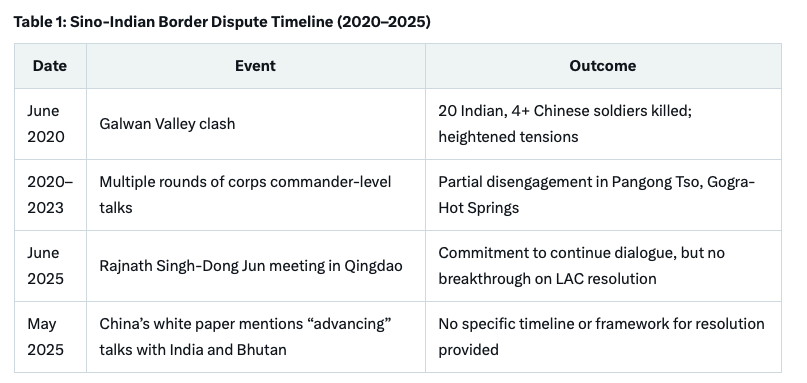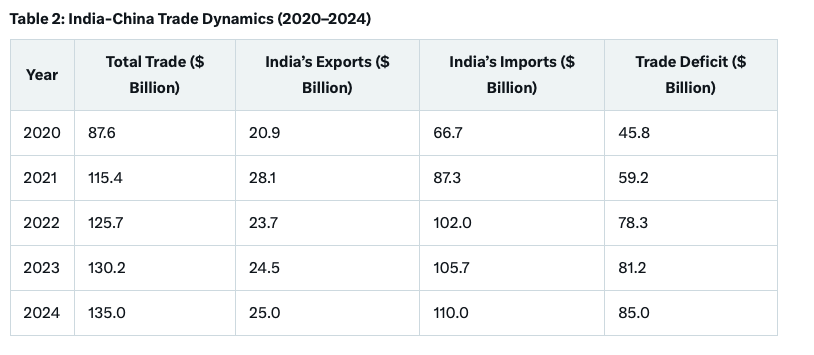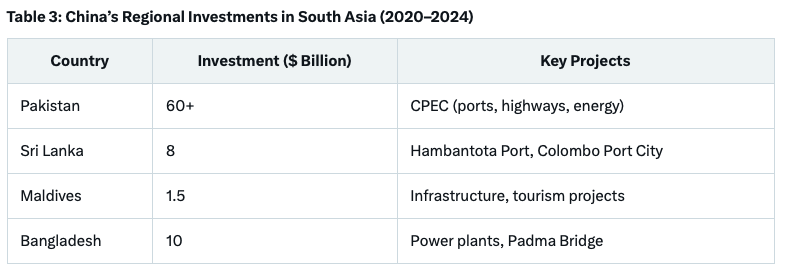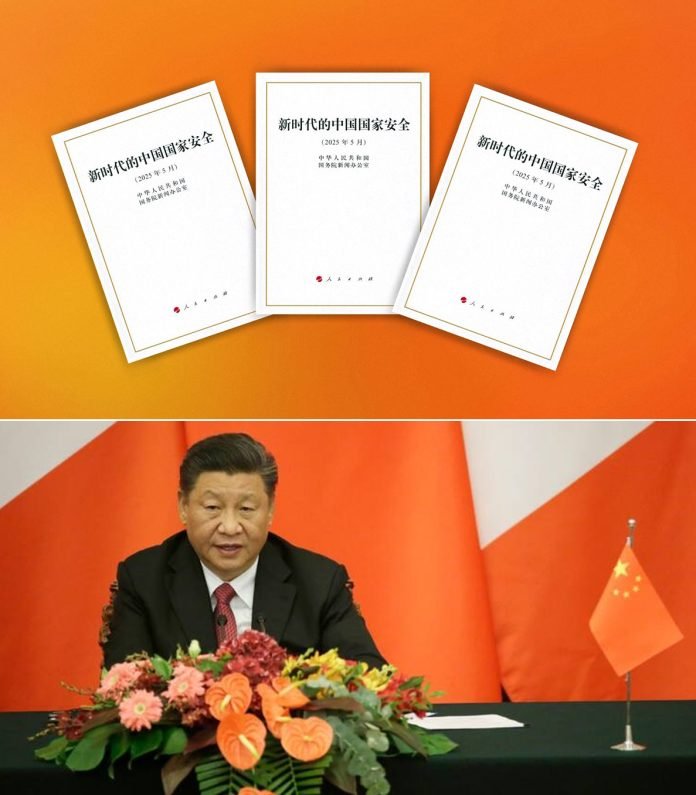In May 2025, China released its inaugural white paper on national security, titled China’s National Security in the New Era. This document has sparked intense debate about its strategic implications, particularly for India. This 23-page Mandarin-language paper outlines China’s security priorities, emphasising the centrality of the Communist Party of China (CPC) in safeguarding national stability while addressing a spectrum of internal and external threats. For India, a rising power sharing a contested 3,488-km border with China, the white paper’s pronouncements carry profound geopolitical, economic, and security ramifications. Amid ongoing border disputes, trade tensions, and China’s expanding influence in South Asia, this document offers critical insights into Beijing’s strategic calculus and its approach to India. This op-ed examines the key themes of the white paper, its implications for India, and the broader regional dynamics, supported by relevant data and analysis.
The White Paper: A Blueprint for CPC Supremacy
China’s white paper articulates a comprehensive security framework, prioritising the CPC’s political and regime security above all else. It identifies a range of threats, from domestic dissent to external pressures, including border disputes with India and Bhutan, tensions in the Taiwan Strait, and perceived Western containment efforts led by the United States. The document portrays China as a victim, striving for peace, while subtly reinforcing its assertive posture in global and regional affairs. Notably, South Asia, including India, receives minimal explicit mention, except in the context of ongoing border talks, which the paper claims are ‘advancing’. This strategic ambiguity raises questions about whether China views India as a secondary concern or is deliberately downplaying its focus to avoid escalating tensions.
The white paper’s emphasis on the CPC’s supremacy underscores Beijing’s intent to consolidate domestic control while projecting strength abroad. It highlights China’s advancements in military modernisation, including its nuclear arsenal, which, according to reports from the Federation of American Scientists (FAS) and the Stockholm International Peace Research Institute (SIPRI), is expanding rapidly. By 2035, China could possess enough fissile material for 1,000 additional warheads, bolstering its nuclear triad and long-range precision strike capabilities. For India, this escalation signals a shift in the regional power balance, particularly given China’s growing military ties with Pakistan and its influence in South Asian nations like the Maldives, Sri Lanka, and Bangladesh.
China’s white paper identifies various threats ranging from internal dissent to external pressures, including border disputes with India and Bhutan, tensions in the Taiwan Strait, and perceived Western containment efforts led by the United States. It portrays China as a victim, striving for peace, while subtly reinforcing its assertive posture in global and regional affairs
Border Disputes and Strategic Ambiguity
The white paper’s brief mention of ‘advancing’ border talks with India and Bhutan belies the complexity of the Sino-Indian border dispute, which remains a flashpoint in bilateral relations. The Line of Actual Control (LAC) has been a site of tension since the 2020 Galwan Valley clash, where 20 Indian and at least four Chinese soldiers lost their lives. Despite 21 rounds of corps commander-level talks and recent diplomatic engagements, such as the June 2025 meeting between Indian Defence Minister Rajnath Singh and Chinese counterpart Dong Jun in Qingdao, a permanent resolution remains elusive. China’s stance, as reiterated in the white paper, is that the border issue should not define the broader relationship, advocating for managed differences until a negotiated settlement is reached. India, however, insists on a ‘permanent solution’ to restore stability along the LAC.
This divergence in approach highlights a strategic mismatch. China’s focus on de-escalation without resolution allows it to maintain pressure on India while pursuing broader regional ambitions. For instance, the white paper notes that China has settled boundary issues with 12 of its 14 land neighbours, leaving India and Bhutan as outliers. This could be interpreted as a signal that China is in no hurry to resolve the dispute, preferring to keep India off-balance. Meanwhile, India’s push for a permanent solution reflects its need for stability to focus on economic growth and regional influence.

Economic Leverage and Trade Tensions
Beyond the border, China’s white paper has implications for India’s economic security. The document’s silence on South Asia’s economic dynamics contrasts with China’s actions, such as restricting exports of rare earth materials and fertilisers to India. According to The Indian Express (June 27, 2025), China has approved only a ‘bare minimum’ flow of rare earths, critical for India’s electronics and defence manufacturing sectors. This move, coupled with halts in fertiliser exports, appears to be a retaliatory response to India’s restrictions on Chinese investments after the Galwan clash. In 2024, India tightened scrutiny of Chinese FDI, citing security concerns, which led to a decline in bilateral trade growth.
The white paper notes that China has settled boundary issues with 12 of its 14 land neighbours, leaving India and Bhutan as outliers. This could be interpreted as a signal that China is in no hurry to resolve the dispute, preferring to keep India off-balance. But India’s push for a permanent solution reflects its need for stability to focus on economic growth and regional influence
China’s economic leverage is significant, given its position as India’s largest trading partner. In 2024, bilateral trade reached $135 billion, with India’s trade deficit at $85 billion, heavily skewed in China’s favour. The white paper’s focus on securing supply chains and critical resources suggests that China may continue to use trade as a strategic tool to pressure India, particularly in sectors where India lacks self-sufficiency.

India’s dependence on Chinese imports for electronics, pharmaceuticals, and critical minerals underscores the need for diversification. The white paper’s emphasis on China’s self-reliance in strategic sectors could inspire India to accelerate initiatives like the Production Linked Incentive (PLI) scheme and the Aatmanirbhar Bharat campaign to reduce reliance on Chinese supply chains.
Regional Influence and the China-Pakistan Nexus
The white paper’s omission of South Asia, except for border talks, is particularly striking given China’s deepening ties with Pakistan, India’s arch-rival. The Hindu (June 28, 2025) highlighted a growing China-Pakistan nexus, with China providing military and diplomatic support to Pakistan, especially after the April 2025 Pahalgam terror attack. The white paper’s silence on Pakistan, despite its strategic importance as a client state, suggests a calculated omission to avoid drawing attention to this sensitive dynamic.
The national security white paper’s silence on China’s nuclear ambitions is deafening, especially in light of reports from FAS and SIPRI (June 2025) detailing China’s rapid nuclear buildup. With an estimated 500 warheads in 2025, China is on track to rival the United States and Russia by 2035
China’s investments in the China-Pakistan Economic Corridor (CPEC), valued at over $60 billion, have strengthened Pakistan’s military and economic resilience, indirectly challenging India’s security. The white paper’s focus on regional stability under China’s Global Security Initiative (GSI) raises concerns about Beijing’s intent to dominate South Asia through proxies like Pakistan. For India, this necessitates a robust counter-strategy, including deeper engagement with Quad partners (the US, Japan, Australia) and regional allies like Bangladesh and Sri Lanka.

Nuclear Expansion and Security Concerns
The white paper’s silence on China’s nuclear ambitions is deafening, especially in light of reports from FAS and SIPRI (June 2025) detailing China’s rapid nuclear buildup. With an estimated 500 warheads in 2025, China is on track to rival the US and Russia by 2035. This expansion, coupled with advancements in hypersonic missiles and long-range precision strike capabilities, poses a direct threat to India’s security. The white paper’s focus on ‘great power competition’ with the US indirectly signals China’s intent to assert dominance in Asia, where India is a key counterweight.
For India, this necessitates strengthening its nuclear deterrence and missile defence systems, such as the Agni-V ICBM and the S-400 air defence system. The white paper’s emphasis on China’s technological advancements also underscores the need for India to invest in indigenous defence R&D to bridge the technological gap.
China’s document necessitates India to strengthen its nuclear deterrence and missile defence systems, such as the Agni-V ICBM and the S-400 air defence system. The white paper’s emphasis on China’s technological advancements underscores the need for India to invest in defence R&D to bridge the technological gap
India’s Response: A Multi-Pronged Strategy
India must adopt a multi-pronged approach to navigate the challenges posed by China’s white paper. First, it should prioritise diplomatic engagement to resolve the LAC dispute, leveraging forums like the Shanghai Cooperation Organisation (SCO), despite India’s rejection of a pro-Pakistan SCO statement in June 2025. Second, India must accelerate economic diversification to reduce dependence on Chinese imports, focusing on critical sectors like rare earths and pharmaceuticals. Third, countering China’s regional influence requires strengthening ties with South Asian neighbours and Quad partners to create a balanced regional architecture. Finally, India must bolster its military modernisation, particularly in cyber and nuclear capabilities, to deter potential Chinese aggression.
Conclusion
China’s national security white paper is a strategic document that reveals as much through its omissions as its explicit statements. For India, it underscores the need for vigilance in addressing border disputes, economic vulnerabilities, and China’s regional ambitions. While the paper projects confidence in China’s stability and global role, its implications for India are profound, demanding a proactive and multifaceted response. As Asia’s two largest powers navigate their complex relationship, the choices made by New Delhi and Beijing will shape the region’s future stability. India must seize this moment to assert its strategic autonomy, leveraging its growing global influence to counterbalance China’s assertive posture.
The writer is Special Advisor for South Asia at Parley Policy Initiative, Republic of Korea. He is a regular commentator on the issues of Water Security and Transboundary River issues in South Asia. The views expressed are of the writer and do not necessarily reflect the views of Raksha Anirveda






